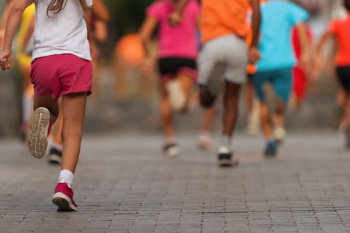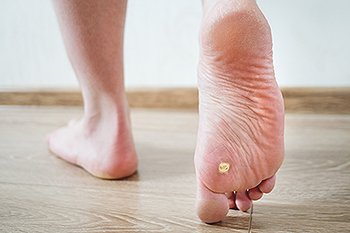Items filtered by date: May 2024
Sever’s Disease Can Affect Your Active Child

Sever's disease is often experienced by active children aged nine to 14. It occurs when the child’s calf muscle and Achilles tendon excessively pull on the growth plate of the heel bone, or calcaneus, which is still developing until about age 15. Sever’s disease typically arises in young athletes, whose vigorous activities put additional strain on their heels. Children may experience pain along the sides of their heels, which intensifies when they stand on tiptoes or run. Some may also notice warmth and swelling in the affected area. A diagnosis is usually based on these symptoms, as X-rays, while helpful for ruling out issues like bone cysts or stress fractures, cannot confirm Sever's disease. Relief options include using heel pads to reduce tendon strain, night splints to stretch the calf muscles, or in severe cases, a cast to immobilize the area. If your active child is experiencing heel pain, it is suggested that you schedule an appointment with a podiatrist for a full exam and appropriate treatment for Sever’s disease.
Sever's disease often occurs in children and teens. If your child is experiencing foot or ankle pain, see one of our podiatrists from Arcadia Foot and Ankle. Our doctors can treat your child’s foot and ankle needs.
Sever’s Disease
Sever’s disease is also known as calcaneal apophysitis, which is a medical condition that causes heel pain I none or both feet. The disease is known to affect children between the ages of 8 and 14.
Sever’s disease occurs when part of the child’s heel known as the growth plate (calcaneal epiphysis) is attached to the Achilles tendon. This area can suffer injury when the muscles and tendons of the growing foot do not keep pace with bone growth. Therefore, the constant pain which one experiences at the back of the heel will make the child unable to put any weight on the heel. The child is then forced to walk on their toes.
Symptoms
Acute pain – Pain associated with Sever’s disease is usually felt in the heel when the child engages in physical activity such as walking, jumping and or running.
Highly active – Children who are very active are among the most susceptible in experiencing Sever’s disease, because of the stress and tension placed on their feet.
If you have any questions, please feel free to contact our offices located in Scottsdale, North Scottsdale, Mesa, and Sun City, AZ . We offer the newest diagnostic and treatment technologies for all your foot and ankle injuries.
Is It Foot Fungus or Psoriasis?

Deciphering whether you have an athlete’s foot infection or psoriasis on the feet can be difficult. Understanding the symptoms can help. Athlete’s foot, a contagious fungal infection thriving in warm, moist environments, typically appears as red, scaly patches between toes or under nails. It may cause itching and discomfort if untreated. On the other hand, psoriasis, an autoimmune disorder, manifests with similar symptoms but is not contagious. Psoriasis lesions may cause silvery scales and vary in color over time. They often involve the soles and nails, causing soreness or tenderness. Nail changes, like pitting or discoloration, are common in psoriasis. While athlete’s foot primarily itches, psoriasis can lead to joint stiffness in addition to discomfort. Treatment approaches also differ. Athlete's foot is usually treated with antifungal medications, while psoriasis management may involve topical treatments, light therapy, or systemic medications. If you have a type of rash on your feet, it is suggested that you schedule an appointment with a podiatrist for a proper diagnosis and appropriate treatment.
Everyday foot care is very important to prevent infection and other foot ailments. If you need your feet checked, contact one of our podiatrists from Arcadia Foot and Ankle. Our doctors can provide the care you need to keep you pain-free and on your feet.
Everyday Foot Care
Often, people take care of their bodies, face and hair more so than they do for their feet. But the feet are a very important aspect of our bodies, and one that we should pay more attention to. Without our feet, we would not be able to perform most daily tasks.
It is best to check your feet regularly to make sure there are no new bruises or cuts that you may not have noticed before. For dry feet, moisturizer can easily be a remedy and can be applied as often as necessary to the affected areas. Wearing shoes that fit well can also help you maintain good foot health, as well as making it easier to walk and do daily activities without the stress or pain of ill-fitting shoes, high heels, or even flip flops. Wearing clean socks with closed shoes is important to ensure that sweat and bacteria do not accumulate within the shoe. Clean socks help to prevent Athlete’s foot, fungi problems, bad odors, and can absorb sweat.
If you have any questions please feel free to contact our offices located in Scottsdale, North Scottsdale, Mesa, and Sun City, AZ . We offer the newest diagnostic and treatment technologies for all your foot and ankle needs.
Plantar Warts Can Be Treated!
Facts About Plantar Warts

Plantar warts, though often considered minor nuisances, hold interesting facts worth exploring. These warts, caused by the human papillomavirus, or HPV, commonly appear on the soles of the feet, particularly in areas subjected to pressure or friction. Unlike other warts, plantar warts grow inward due to the pressure exerted by walking, leading to a flattened appearance. They may present as small, grainy growths or larger, cauliflower-like clusters. Plantar warts can be painful, especially while walking or standing, as they press into the skin and nerves. Despite their viral origin, they are not highly contagious and are more likely to develop in individuals with weakened immune systems or through direct contact with contaminated surfaces. If you have a plantar wart, it is suggested that you consult a podiatrist who can offer you the treatment option that is right for you.
Plantar warts can be very uncomfortable. If you need your feet checked, contact one of our podiatrists from Arcadia Foot and Ankle. Our doctors will assist you with all of your foot and ankle needs.
About Plantar Warts
Plantar warts are the result of HPV, or human papillomavirus, getting into open wounds on the feet. They are mostly found on the heels or balls of the feet.
While plantar warts are generally harmless, those experiencing excessive pain or those suffering from diabetes or a compromised immune system require immediate medical care. Plantar warts are easily diagnosed, usually through scraping off a bit of rough skin or by getting a biopsy.
Symptoms
- Lesions on the bottom of your feet, usually rough and grainy
- Hard or thick callused spots
- Wart seeds, which are small clotted blood vessels that look like little black spots
- Pain, discomfort, or tenderness of your feet when walking or standing
Treatment
- Freezing
- Electric tool removal
- Laser Treatment
- Topical Creams (prescription only)
- Over-the-counter medications
To help prevent developing plantar warts, avoid walking barefoot over abrasive surfaces that can cause cuts or wounds for HPV to get into. Avoiding direct contact with other warts, as well as not picking or rubbing existing warts, can help prevent the further spread of plantar warts. However, if you think you have developed plantar warts, speak to your podiatrist. He or she can diagnose the warts on your feet and recommend the appropriate treatment options.
If you have any questions please feel free to contact our offices located in Scottsdale, North Scottsdale, Mesa, and Sun City, AZ . We offer the newest diagnostic and treatment technologies for all your foot and ankle needs.
Treatment for Athlete’s Foot
 Athlete's foot is a fungal infection that thrives in moist, warm environments. This makes it common for people who wear tight, sweaty shoes for extended periods or use communal showers and locker rooms. The fungus infects the skin in the toes and causes itching, burning, and peeling. A podiatrist, or foot doctor, may suggest antifungal medications to apply topically, usually for a couple of weeks until the infection clears up. For more severe cases, oral antifungal medications may be prescribed. Preventative measures include keeping the feet clean and dry, changing socks regularly, and wearing well-ventilated shoes. Antifungal powders for shoes and socks may also be suggested as prevention. In addition, avoiding barefoot walking in public areas and using separate towels for your feet can help prevent the spread and recurrence of athlete's foot. If you suspect an athlete’s foot, it is suggested that you make an appointment with a podiatrist for relief.
Athlete's foot is a fungal infection that thrives in moist, warm environments. This makes it common for people who wear tight, sweaty shoes for extended periods or use communal showers and locker rooms. The fungus infects the skin in the toes and causes itching, burning, and peeling. A podiatrist, or foot doctor, may suggest antifungal medications to apply topically, usually for a couple of weeks until the infection clears up. For more severe cases, oral antifungal medications may be prescribed. Preventative measures include keeping the feet clean and dry, changing socks regularly, and wearing well-ventilated shoes. Antifungal powders for shoes and socks may also be suggested as prevention. In addition, avoiding barefoot walking in public areas and using separate towels for your feet can help prevent the spread and recurrence of athlete's foot. If you suspect an athlete’s foot, it is suggested that you make an appointment with a podiatrist for relief.
Athlete’s Foot
Athlete’s foot is often an uncomfortable condition to experience. Thankfully, podiatrists specialize in treating athlete’s foot and offer the best treatment options. If you have any questions about athlete’s foot, consult with one of our podiatrists from Arcadia Foot and Ankle. Our doctors will assess your condition and provide you with quality treatment.
What Is Athlete’s Foot?
Tinea pedis, more commonly known as athlete’s foot, is a non-serious and common fungal infection of the foot. Athlete’s foot is contagious and can be contracted by touching someone who has it or infected surfaces. The most common places contaminated by it are public showers, locker rooms, and swimming pools. Once contracted, it grows on feet that are left inside moist, dark, and warm shoes and socks.
Prevention
The most effective ways to prevent athlete’s foot include:
- Thoroughly washing and drying feet
- Avoid going barefoot in locker rooms and public showers
- Using shower shoes in public showers
- Wearing socks that allow the feet to breathe
- Changing socks and shoes frequently if you sweat a lot
Symptoms
Athlete’s foot initially occurs as a rash between the toes. However, if left undiagnosed, it can spread to the sides and bottom of the feet, toenails, and if touched by hand, the hands themselves. Symptoms include:
- Redness
- Burning
- Itching
- Scaly and peeling skin
Diagnosis and Treatment
Diagnosis is quick and easy. Skin samples will be taken and either viewed under a microscope or sent to a lab for testing. Sometimes, a podiatrist can diagnose it based on simply looking at it. Once confirmed, treatment options include oral and topical antifungal medications.
If you have any questions, please feel free to contact our offices located in Scottsdale, North Scottsdale, Mesa, and Sun City, AZ . We offer the newest diagnostic and treatment technologies for all your foot care needs.
